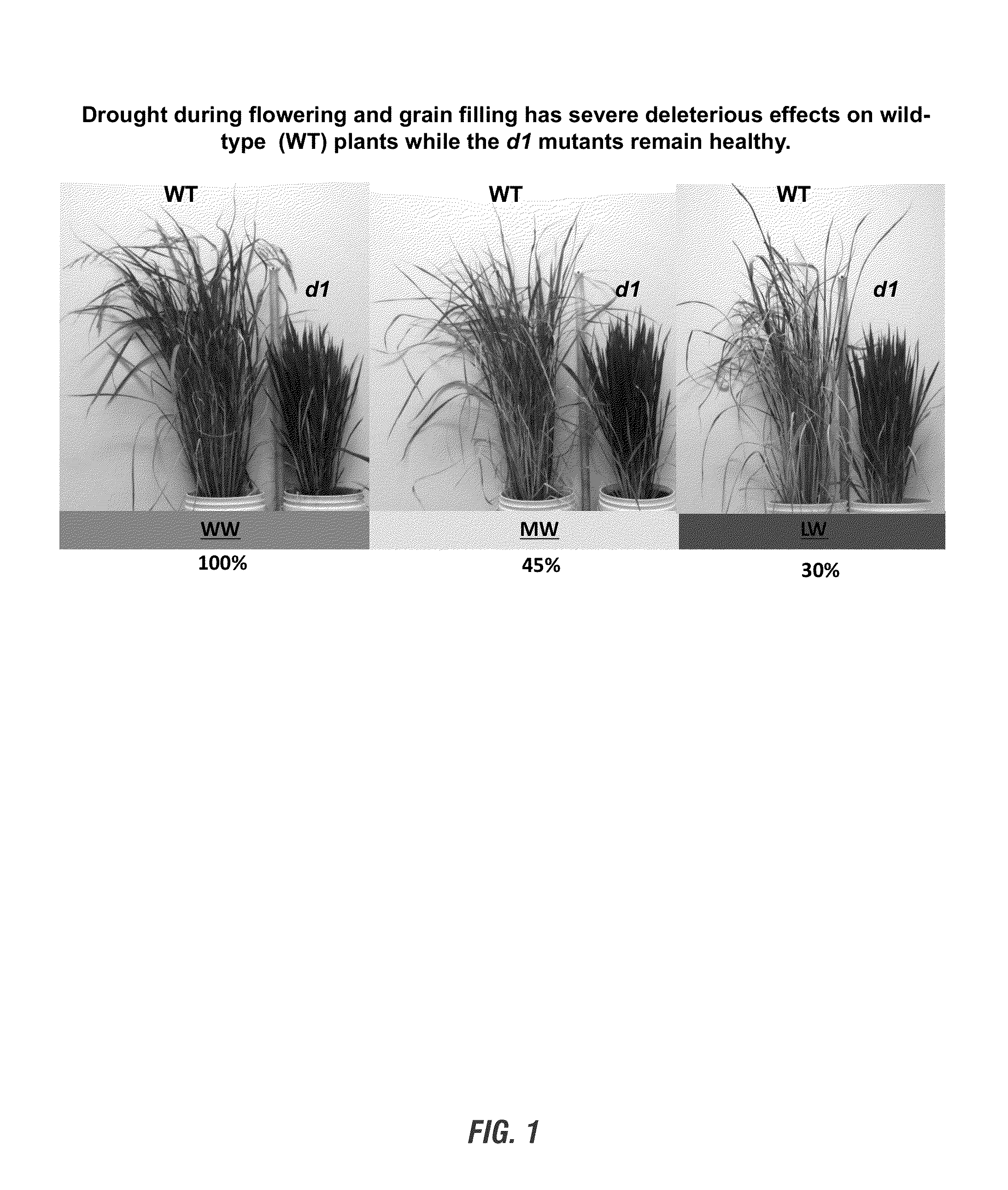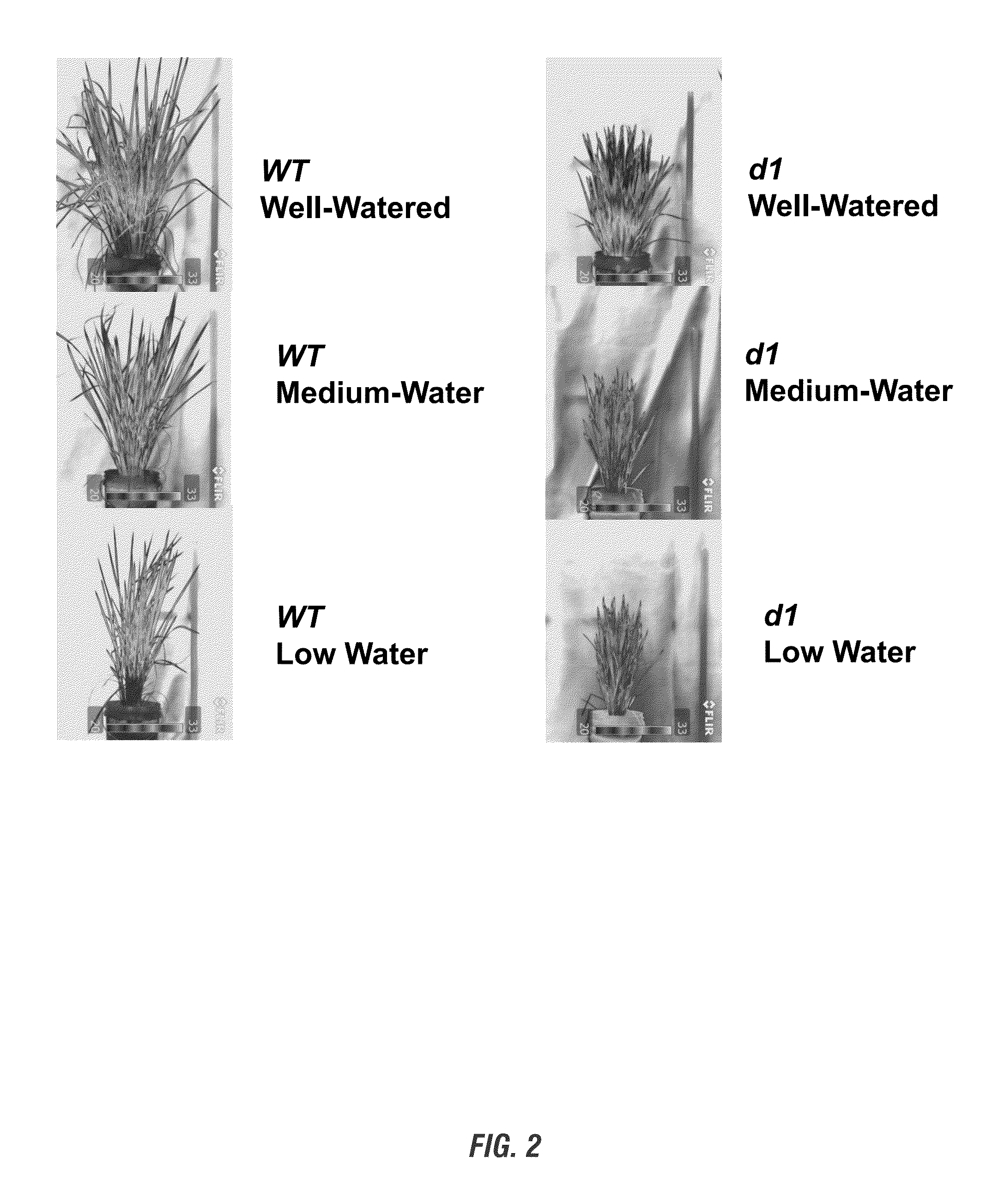Methods of improving drought tolerance and seed production in rice
a technology of drought tolerance and rice, applied in the field of methods of improving drought tolerance and seed production in rice, can solve the problems of limiting the application of knowledge, so as to improve the yield and yield, the effect of reducing heigh
- Summary
- Abstract
- Description
- Claims
- Application Information
AI Technical Summary
Benefits of technology
Problems solved by technology
Method used
Image
Examples
example 1
P14 Characterization of Drought Tolerance in the Rice G-Protein a Subunit Mutant, d1
[0180]The rice dwarf mutant, d1, contains a non-functional RGA1 gene, encoding the GTP-binding α-subunit of the heterotrimeric G protein. This mutant was originally isolated as a spontaneous mutant with reduced height and shorter, erect, thicker, broad, dark green leaves, compact panicles, and short, round grains. We have examined the physiological responses of the d1 mutant to mild and severe water limitation during both vegetative and reproductive development in comparison with its background line. The d1 plants present higher photosynthetic rates, stomatal conductance, and ψleaf than wild type during both mild and severe water limitation, and have a greater number and percentage of tillers producing panicles, with resulting higher reproductive yield. The d1 plants also perform better than wild-type plants under high planting densities.
[0181]FIG. 1 shows water stress during flowering and grain fill...
example 2
Plant Heterotrimeric G Protein Function: Insights from Arabidopsis and Rice Mutants Laetitia Perfus-Barbeoch, Alan M. Jones and Sarah M. Assmann
[0194]Heterotrimeric G proteins have been implicated in a wide range of plant processes. These include responses to hormones, drought, and pathogens, and developmental events such as lateral root formation, hypocotyl elongation, hook opening, leaf expansion, and silique development. Results and concepts emerging from recent phenotypic analyses of G-protein component mutants in Arabidopsis and rice are adding to our understanding of G-protein mechanisms and functions in higher plants.
Introduction
[0195]Heterotrimeric GTP-binding proteins (G proteins) provide a key mechanism by which a specific signaling cascade is switched on or off to translate an incoming signal into a specific cellular response. In recent years, much has been learned about the diversity of signal transduction through plant G proteins thanks to the identification and mutatio...
example 3
[0278]Heterotrimeric G Proteins Regulate Reproductive Trait Plasticity in Response to Water Availability
Summary
[0279]Phenotypic plasticity is the ability of one genotype to display different phenotypes under different environmental conditions. Although variation for phenotypic plasticity has been document in numerous species, little is known about the genetic mechanisms underlying phenotypic plasticity. Given their widespread roles in hormonal and environmental signaling, we examined whether genes which encode heterotrimeric G proteins are plasticity genes.
[0280]We grew multiple alleles of heterotrimeric G-protein mutants, together with wild-type Arabidopsis thaliana, under different watering regimes to determine the contributions of G-protein genes to phenotypic plasticity for a number of developmental and reproduction-related traits.
[0281]G-protein mutations did not affect significantly the amount of phenotypic variation within an environment for any trait, but did affect signific...
PUM
| Property | Measurement | Unit |
|---|---|---|
| area | aaaaa | aaaaa |
| temperature | aaaaa | aaaaa |
| temperature | aaaaa | aaaaa |
Abstract
Description
Claims
Application Information
 Login to View More
Login to View More - R&D
- Intellectual Property
- Life Sciences
- Materials
- Tech Scout
- Unparalleled Data Quality
- Higher Quality Content
- 60% Fewer Hallucinations
Browse by: Latest US Patents, China's latest patents, Technical Efficacy Thesaurus, Application Domain, Technology Topic, Popular Technical Reports.
© 2025 PatSnap. All rights reserved.Legal|Privacy policy|Modern Slavery Act Transparency Statement|Sitemap|About US| Contact US: help@patsnap.com



